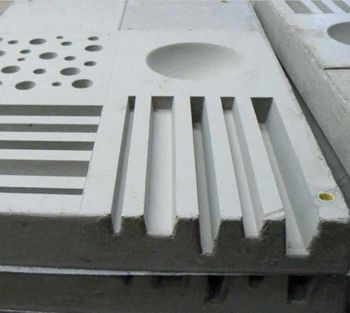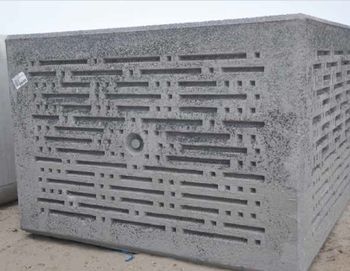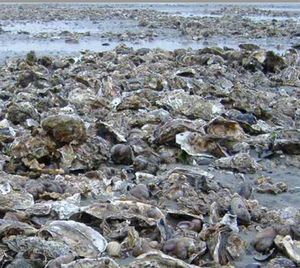Difference between revisions of "Ecological enhancement of coastal protection structures"
Dronkers J (talk | contribs) |
Dronkers J (talk | contribs) |
||
| Line 2: | Line 2: | ||
==Introduction== | ==Introduction== | ||
Large coastal stretches around the world have been armored with hard protection structures. For example, 14% of the United States coastline (Popkin, 2015<ref>Popkin, G. 2015. Fourteen percent of U.S. coastline is covered in concrete. Science [Online]. Available: https://www.sciencemag.org/ | Large coastal stretches around the world have been armored with hard protection structures. For example, 14% of the United States coastline (Popkin, 2015<ref>Popkin, G. 2015. Fourteen percent of U.S. coastline is covered in concrete. Science [Online]. Available: https://www.sciencemag.org/ | ||
| − | news/2015/08/fourteen-percent-us-coastline-covered-concrete.</ref>) and 60% of the natural coastline in China have been replaced by seawalls (Ma et al., 2014<ref>Ma, Z., Melville, D.S., Liu, J., Chen, Y., Yang, H., Ren, W., Zhang, Z., Piersma, T. and Li, B. 2014. Rethinking China's new great wall. Science. 346:912–914</ref>). | + | news/2015/08/fourteen-percent-us-coastline-covered-concrete.</ref>) and 60% of the natural coastline in China have been replaced by hard seawalls (Ma et al., 2014<ref>Ma, Z., Melville, D.S., Liu, J., Chen, Y., Yang, H., Ren, W., Zhang, Z., Piersma, T. and Li, B. 2014. Rethinking China's new great wall. Science. 346:912–914</ref>). |
The biodiversity of ecosystems that develop on artificial hard coastal protection structures is lower than the biodiversity on natural hard substrates in the same environment. | The biodiversity of ecosystems that develop on artificial hard coastal protection structures is lower than the biodiversity on natural hard substrates in the same environment. | ||
| − | As compared to the largely horizontal and topographically complex surfaces of natural substrates, marine urban infrastructure typically has vertical, smooth | + | As compared to the largely horizontal and topographically complex surfaces of natural substrates, marine urban infrastructure typically has vertical, smooth surface that reduces the area for attachment and the diversity of habitat niches for organisms, and provides fewer refuges from predators, competitors and/or environmental stressors <ref name=S17>Strain, E.M.A., Olabarria, C., Mayer-Pinto,M., Cumbo, V., Morris, R.L., Bugnot, A.B., Dafforn, K.A., Heery, E., Firth, L.B., Brooks, P.R. and Bishop, M.J. 2017. Eco-engineering urban infrastructure for marine and coastal biodiversity: which interventions have the greatest ecological benefit? J. Appl. Ecol. 55: 426–441</ref>. It has been shown, for example, that surface roughness positively affects the build-up of marine biofilms, increases primary productivity and enhances further community development. Conversely, attached macro- and microalgae on concrete can reduce its exposure to variations in temperature and humidity<ref>Coombes, M. A., Viles, H. A., Naylor, L. A. and La Marca, E. C. 2017. Cool Barnacles: Do Common Biogenic Structures Enhance or Retard Rates of Deterioration of Intertidal Rocks and Concrete? Science of the Total Environment 580: 1034–1045</ref>, and calcium carbonate-forming epifauna can protect concrete structures from weathering and erosion<ref>Kawabata, Y., Kato, E. and Iwanami, M. 2012. Enhanced Long-Term Resistance of Concrete with Marine Sessile Organisms to Chloride Ion Penetration. Journal of Advanced Concrete Technology 10: 151–159</ref>, enhancing the durability of the concrete in both cases. |
==Eco-engineering artificial structures== | ==Eco-engineering artificial structures== | ||
Minor interventions can greatly enhance the habitat function of artificial hard structures for the development of more diverse ecosystems. | Minor interventions can greatly enhance the habitat function of artificial hard structures for the development of more diverse ecosystems. | ||
| − | A common technique for eco-engineering marine infrastructure consists of increasing surface area and/or habitat complexity of the hard substrate at a range of scales (mm to metres) using either additive (i.e. attachment of protruding structures) or subtractive (i.e. drilling, removal of substrate) processes. Fine-scale (μm-cm) surface roughness greatly improves the early phase colonisation of marine organisms. The abundance and number of species that settle on these eco-engineered structures are much higher than on conventional smooth structures. | + | A common technique for eco-engineering marine infrastructure consists of increasing surface area and/or habitat complexity of the hard substrate at a range of scales (mm to metres) using either additive (i.e. attachment of protruding structures) or subtractive (i.e. drilling, removal of substrate) processes. Fine-scale (μm-cm) surface roughness greatly improves the early phase colonisation of marine organisms. The abundance and number of species that settle on these eco-engineered structures are much higher than on conventional smooth structures. Suitable adaptations of artificial hard structures can provide shading and water-retaining microhabitats for intertidal organisms to prevent thermal and desiccation stress at low tide<ref>MacArthur, M., Naylor, L.A., Hansom, J.D. and Burrows, M.T. 2020. Ecological enhancement of coastal engineering structures: Passive enhancement techniques. Science of the Total Environment 740, 139981</ref>. |
The comparative analysis of Strain et al. (2017<ref name=S17/>) showed that | The comparative analysis of Strain et al. (2017<ref name=S17/>) showed that | ||
* in the intertidal zone, interventions that provided moisture and shade had the greatest effect on the richness of sessile and mobile organisms, while water-retaining features had the greatest effect on the richness of fish species; | * in the intertidal zone, interventions that provided moisture and shade had the greatest effect on the richness of sessile and mobile organisms, while water-retaining features had the greatest effect on the richness of fish species; | ||
| Line 56: | Line 56: | ||
==Related articles== | ==Related articles== | ||
| + | :[[Nature-based shore protection]] | ||
:[[Rocky shore habitat]] | :[[Rocky shore habitat]] | ||
| − | |||
Revision as of 12:18, 31 March 2023
Contents
Introduction
Large coastal stretches around the world have been armored with hard protection structures. For example, 14% of the United States coastline (Popkin, 2015[1]) and 60% of the natural coastline in China have been replaced by hard seawalls (Ma et al., 2014[2]).
The biodiversity of ecosystems that develop on artificial hard coastal protection structures is lower than the biodiversity on natural hard substrates in the same environment. As compared to the largely horizontal and topographically complex surfaces of natural substrates, marine urban infrastructure typically has vertical, smooth surface that reduces the area for attachment and the diversity of habitat niches for organisms, and provides fewer refuges from predators, competitors and/or environmental stressors [3]. It has been shown, for example, that surface roughness positively affects the build-up of marine biofilms, increases primary productivity and enhances further community development. Conversely, attached macro- and microalgae on concrete can reduce its exposure to variations in temperature and humidity[4], and calcium carbonate-forming epifauna can protect concrete structures from weathering and erosion[5], enhancing the durability of the concrete in both cases.
Eco-engineering artificial structures
Minor interventions can greatly enhance the habitat function of artificial hard structures for the development of more diverse ecosystems. A common technique for eco-engineering marine infrastructure consists of increasing surface area and/or habitat complexity of the hard substrate at a range of scales (mm to metres) using either additive (i.e. attachment of protruding structures) or subtractive (i.e. drilling, removal of substrate) processes. Fine-scale (μm-cm) surface roughness greatly improves the early phase colonisation of marine organisms. The abundance and number of species that settle on these eco-engineered structures are much higher than on conventional smooth structures. Suitable adaptations of artificial hard structures can provide shading and water-retaining microhabitats for intertidal organisms to prevent thermal and desiccation stress at low tide[6]. The comparative analysis of Strain et al. (2017[3]) showed that
- in the intertidal zone, interventions that provided moisture and shade had the greatest effect on the richness of sessile and mobile organisms, while water-retaining features had the greatest effect on the richness of fish species;
- in the subtidal zone, small-scale depressions which provide refuge to new recruits from predators and other environmental stressors such as waves, had higher abundances of sessile organisms, while elevated structures had higher numbers and abundances of fish. The taxa that responded most positively to eco-engineering in the intertidal were those whose body size most closely matched the dimensions of the resulting intervention.
Precast concrete units have been developed that can be used for ecological enhancement of marine structures. The Reef Ball (see Artificial reefs) can be used for a variety of purposes, ranging from coral and oyster reef rehabilitation to mangrove planting. Other concrete units with multiple habitats have been developed for the armoring of breakwaters[7] (Fig. 1). Oyster shell bags can serve for wave attenuation as an alternative to gabions or rock structures[8].
 Fig. 1a. Precast concrete revetment with multiple habitat structures. Photo credit: Deltares[9]. |
 Fig. 1b. Precast concrete armor block with multiple habitat structures. Photo credit: Deltares[9]. |
Native and non-native species
The introduction of artificial habitats in a natural environment promotes the establishment of non-native species. This is obvious when hard structures are introduced in sedimentary coastal environments where rock or other hard elements are completely absent. However, non-indigenous species also appear more prevalent on artificial structures when comparable natural habitats are nearby[10]. For example, Airoldi et al. (2015[11]) found that non-indigenous species were two or three times more abundant on infrastructure built along sedimentary coastlines than on natural rocky reefs or infrastructure built close to rocky coastlines in the northern Adriatic. Several possible causes have been proposed[7]. For example, the lower species diversity and density of artificial structures compared to natural habitats implies a lesser resistance to the establishment of invasive species. The high levels of physical (wave) disturbance of artificial structures facilitates colonization by opportunistic species. Marine infrastructure in areas frequented by ships and other transport vectors are particularly susceptible to the establishment of non-indigenous species. Pre-seeding substrates with native fouling species (e.g. habitat forming algae) can strongly reduce occupation by non-indigenous species[12]. Traditional control methods such as chemical treatment or mechanic removal of organisms have serious drawbacks. It has been suggested that biocontrol, i.e., control by natural predators, either native or non- indigenous, could overcome these limitations[13].
Ecosystem connectivity
Local artificial habitats can either stimulate or disrupt the connections within the larger ecosystem. It can provide stepping stones for the dispersal of threatened species, but it can also facilitate the spread of harmful species. Inversely, artificial structures can disrupt connectivity in ecosystems by changing flow patterns and modifying transport pathways[7]. The design of large-scale deployments of artificial habitats thus requires understanding of the dispersal routes of targeted species.

Biogenic reefs
The use of hard structures can in some cases be reduced or avoided by creating a suitable habitat for certain ecosystem engineer species that perform the same functions and sustain themselves with self-generative properties. Examples are:
- Coral reef restoration and creation.
Coral reefs are very effective wave attenuators under storm conditions, besides offering an essential habitat for many marine organisms, see Coral reefs. Restoring degraded coral reefs can be an advantageous alternative to artificial coastal protection structures. Good results have been achieved with techniques involving coral gardening as intermediate step, where fragmented or recruited corals are grown in sheltered sites before transplantation to natural habitats[14]. Extension of coral reefs has been experimented with success by transplanting corals on a substrate of artificial reefs[15].
- Oyster reefs.
The development of oyster reefs can be stimulated by creating an appropriate substrate, for example limestone or concrete or loose shells within a rigid frame[16]. Oyster reefs offer a valuable habitat and effectively reduce coastal erosion by waves and currents. Oyster reefs essentially fulfil a breakwater function, but as they do not grow around or above high water, they cannot replace revetments for providing protection against flooding during storm surges[17][18].
See also: Biogenic reefs of Europe and temporal variability, Dynamics, threats and management of biogenic reefs.
Use of vegetation
Combining increased erosion resistance and ecological value can also be achieved by use of vegetation, either directly on the coastal protection structure or in front of it.
- Natural grass-covered sea dikes.
In Germany, sea dikes usually have a grass-covered gentle slope of about 1/7 as protection against erosion by (overtopping) waves; hard revetments are used only at the most exposed locations. Studies showed that species-rich grass cover had the highest erosion resistance, which occurred for dikes where no fertilizer was used[19]. The erosion resistance of vegetated sea dikes can be further enhanced by putting the grass cover on top of a hard or flexible geogrid structure or by seeding the grass on turf reinforcement mats[19]. See also Overtopping resistant dikes.
- Foreland restoration and creation
Restoration or creation of forelands are environment-friendly solutions to circumvent the need for enlarging hard coastal protection structures under sea level rise. On exposed sandy coasts, raising and widening the beach through shore nourishment with offshore dredged sand can provide additional protection against erosion and wave attack. Further protection can be provided by beach vegetation, see Shore protection vegetation. On less energetic coasts, wave attenuation can be achieved by restoring or stimulating the development of mangroves (in tropical and subtropical zones, see Mangroves) or salt marshes (in temperate zones, see Restoration of estuarine and coastal ecosystems).
Related articles
References
- ↑ Popkin, G. 2015. Fourteen percent of U.S. coastline is covered in concrete. Science [Online]. Available: https://www.sciencemag.org/ news/2015/08/fourteen-percent-us-coastline-covered-concrete.
- ↑ Ma, Z., Melville, D.S., Liu, J., Chen, Y., Yang, H., Ren, W., Zhang, Z., Piersma, T. and Li, B. 2014. Rethinking China's new great wall. Science. 346:912–914
- ↑ 3.0 3.1 Strain, E.M.A., Olabarria, C., Mayer-Pinto,M., Cumbo, V., Morris, R.L., Bugnot, A.B., Dafforn, K.A., Heery, E., Firth, L.B., Brooks, P.R. and Bishop, M.J. 2017. Eco-engineering urban infrastructure for marine and coastal biodiversity: which interventions have the greatest ecological benefit? J. Appl. Ecol. 55: 426–441
- ↑ Coombes, M. A., Viles, H. A., Naylor, L. A. and La Marca, E. C. 2017. Cool Barnacles: Do Common Biogenic Structures Enhance or Retard Rates of Deterioration of Intertidal Rocks and Concrete? Science of the Total Environment 580: 1034–1045
- ↑ Kawabata, Y., Kato, E. and Iwanami, M. 2012. Enhanced Long-Term Resistance of Concrete with Marine Sessile Organisms to Chloride Ion Penetration. Journal of Advanced Concrete Technology 10: 151–159
- ↑ MacArthur, M., Naylor, L.A., Hansom, J.D. and Burrows, M.T. 2020. Ecological enhancement of coastal engineering structures: Passive enhancement techniques. Science of the Total Environment 740, 139981
- ↑ 7.0 7.1 7.2 Firth, L.B., Knights, A.M., Bridger, D., Evans, A.J., Mieszkowska, N., Moore, P.J., O'Connor, N.E., Sheenan, E.V., Thompson, R.C. and Hawkins, S.J. 2016. Ocean sprawl: challenges and opportunities for biodiversity management in a changing world. Oceanography and Marine Biology: An Annual Review 2016: 193-269
- ↑ Allen, R.J. and Webb, B.M. 2011. Determination of Wave Transmission Coefficients for Oyster Shell Bag Breakwaters. In: Magoon, O.T., Noble, R.M., Treadwell, D.D. and Kim, Y.C. Eds. Coastal Engineering Practice. American Society of Civil Engineers, Reston, VA, USA, pp. 684–697
- ↑ 9.0 9.1 9.2 Reinders, J. and van Wesenbeeck, B. (eds.) 2013. Eco-engineering in the Netherlands. Soft interventions with a solid impact. Deltares http://publications.deltares.nl/Deltares058.pdf
- ↑ Mineur, F., Davies, A.J., Maggs, C.A., Verlaque, M. and Johnson, M.P. 2010. Fronts, jumps and secondary introductions suggested as different invasion patterns in marine species, with an increase in spread rates over time. Proceedings of the Royal Society B: Biological Sciences 277: 2693–2701
- ↑ Airoldi, L., Turon, X., Perkol- Finkel, S. and Rius, M. 2015. Corridors for aliens but not for natives: effects of marine urban sprawl at a regional scale. Diversity and Distributions 21: 755–768
- ↑ Dafforn, K.A. 2017. Eco-engineering and management strategies for marine infrastructure to reduce establishment and dispersal of non-indigenous species. Management of Biological Invasions 8: 153–161
- ↑ Atalah, J., Newcombe, E.M., Hopkins, G.A. and Forrest, B.M. 2014. Potential biocontrol agents for biofouling on artificial structures. Biofouling 30: 999–1010
- ↑ Young, C. N., Schopmeyer, S. A., and Lirman, D. 2012. A review of reef restoration and coral propagation using the threatened genus Acropora in the Caribbean and Western Atlantic. Bul. Mar. Sci. 88: 1075–1098
- ↑ Perkol-Finkel, S. and Benayahu, Y. 2009. The role of differential survival patterns in shaping coral communities on neighboring artificial and natural reefs. Journal of Experimental Marine Biology and Ecology 369: 1–7
- ↑ Goelz, T., Vogt, B. and Hartley, T. 2020. Alternative substrates used for oyster reef restoration: a review. Journal of Shellfish Research 39: 1–12
- ↑ Scyphers, S.B., Powers, S.P., Heck, K.L. and Byro, D. 2011. Oyster Reefs as Natural Breakwaters Mitigate Shoreline Loss and Facilitate Fisheries. PLoS ONE 6 (8), e22396
- ↑ Borsje, B.W., van Wesenbeeck, B.K., Dekker, F., Paalvast, P., Bouma, T.J., van Katwijk, M.M. and de Vries, M.B. 2011. How ecological engineering can serve in coastal protection. Ecol. Eng. 37: 113–122
- ↑ 19.0 19.1 Scheres, B. and Schüttrumpf, H. 2019. Enhancing the ecological value of sea dikes. Water 11, 1617
Please note that others may also have edited the contents of this article.
|